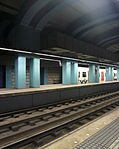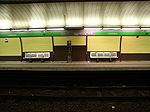Plaça Molina (Barcelona–Vallès Line)

Plaça Molina is a station of the Barcelona Metro on the FGC-operated line L7 (also known as Línia de Balmes). The station is situated under by Plaça Molina, a square in the Sarrià-Sant Gervasi district. It is connected by an underground pedestrian passageway to the nearby Sant Gervasi station on line L6 of the metro.The station opened in 1953, with the inauguration of the railway section spanning from Gràcia to Avinguda Tibidabo (still the terminus of the line). The link to Sant Gervasi station opened in 2008.The station has twin tracks, with two 60 metres (200 ft) long side platforms. Because of proximity to street level, each platform has its own street access, with the two platforms being linked by an underpass below the track level.
Excerpt from the Wikipedia article Plaça Molina (Barcelona–Vallès Line) (License: CC BY-SA 3.0, Authors, Images).Plaça Molina (Barcelona–Vallès Line)
Plaça de Molina, Barcelona
Geographical coordinates (GPS) Address Nearby Places Show on map
Geographical coordinates (GPS)
| Latitude | Longitude |
|---|---|
| N 41.401388888889 ° | E 2.1475 ° |
Address
Pl Molina
Plaça de Molina
08001 Barcelona (Sarrià - Sant Gervasi)
Catalonia, Spain
Open on Google Maps











